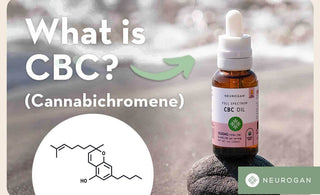Cannabichromene (CBC) is one of the most abundant cannabinoids found in the cannabis plant, next to CBD, THC, and CBG.
Despite its discovery 55 years ago in 1966, the research surrounding this cannabinoid is extremely limited and has only been gaining attention alongside CBD's re-emergence into the spotlight.
Similar to CBD, CBG does a poor job at binding to the endocannabinoid system's CB1 and CB2 receptors and it's a non-psychoactive compound. Instead, CBC Oil has been observed to have unique interactions with TRPV1 and TRPA1 receptors (vanilloid 1 and ankyrin 1 receptors).
Some studies suggest that these receptors play an important role in pain perception, stimulate the production of the body's naturally occurring endocannabinoids, and help to regulate major cell functions [1].
What is CBC & what are its Benefits?
Cannabichromene (CBC) may support healthy skin by reducing mild inflammation and helping with breakouts, though it’s less potent than CBD. CBC has shown potential in pre-clinical studies for inhibiting cancer cell growth and supporting brain function by aiding in the differentiation of vital brain cells.
Cannabichromene (CBC) is a non-psychotropic cannabinoid that's considered one of the four main cannabinoids in the Cannabis sativa plant.
CBC has the same origins as THC and CBD. It comes from the CBGa molecule, so it has similar actions towards supporting a healthy inflammatory response, regulating pain signals, and anti-fungal effects [2].
Most of the research investigating the interactions of cannabis plants in the human body involves THC and CBD, but CBC is gaining a lot more exposure in recent years for its unique interactions at TRP receptors and for its synergistic effects with other cannabinoids for the entourage effect [1].
TRP receptors are involved with regulating fundamental cell functions from proliferation, relaxation, contraction, and apoptosis (programmed cell death).
CBC’s effects are generally weaker than CBD, and research on CBC is still limited.
There is currently no FDA-approved CBC-based medication for any specific treatment.
Difference Between CBC & CBD?
The main differences between CBC and CBD are the molecule structures and concentrations in the hemp plant.
CBC is often mistaken in lab tests for CBD. However, CBC has a unique chemical structure of its own (C21H30O2), which lends a slightly unique effect profile (which we'll get into more detail shortly).
The most notable difference is CBC's affinity to vanilloid receptors (TRPA1 and TRPV1), which play an important role in pain perception and cell function [1].
Cannabichromene & Its Effect
The entourage effect is a phenomenon in plant medicine that describes multiple botanical compounds working together to amplify the effects of one another and reduce the chances of adverse effects.
The entourage effect in cannabis was first proposed by professors, Dr. Raphael Mechoulan and Shimon Ben Shabat in 1998.
The cannabis plant is known for its complex molecular profile of cannabinoids and terpenes, and it's suggested that to leverage the full potential of CBD or THC, the presence of other phytochemicals are just as important in supporting the endocannabinoid system.
In CBC's discovery, it was found to be the third most abundant cannabinoid, thus lending a lot of support to the entourage effect. Most of the studies surrounding CBC's pharmacology found it to be weaker than THC and CBD on its own but helped to support overall endocannabinoid function when combined with the two main cannabis compounds. Like CBC, other cannabinoids such as CBN also interact with the endocannabinoid system in distinct ways, influencing their potential benefits and effects. Understanding the differences between CBC and CBG and other cannabinoids can help you determine which best supports your wellness goals.
With CBC becoming more and more popular, you're likely to come across CBC isolate products—oils, gummies, topicals, vape products—that may have marketing language that promises all the potential benefits from the research we've listed above. It's important to read between the lines of the marketing jargon and to carefully look at the studies.
In the studies we've summarized above, CBC has more profound effects alongside its sister cannabinoids. Rather than seeking out CBC isolate hemp products, it's best to shop for full spectrum or broad spectrum (THC-free) extracts which maintain a diverse range of plant compounds.
How does CBC work in Weed?
CBC works in weed by interacting with the endocannabinoid system (ECS) to help regulate functions like stress, inflammation, and energy metabolism. Unlike THC, CBC is non-psychoactive and enhances the effectiveness of other cannabinoids through the entourage effect.
How Much CBC Should You Take?
There’s no official dosage guide for cannabichromene (CBC), mainly because research is still limited and no CBC-specific medications exist. That said, most CBC products on the market follow dosing patterns similar to CBD.
General CBC dosage ranges:
• Low dose: 5–15mg
• Moderate dose: 15–40mg
• High dose: 40–100mg+
Start low and give your body time to respond—especially if you’re using CBC oil or gummies.
Track how you feel after each use and increase only if necessary. Keep in mind that CBC is more effective when taken with other cannabinoids (full or broad spectrum), so you may need less compared to using an isolate.
Is Cannabichromene Legal?
Yes, Cannabichromene (CBC) is regulated under the same laws as CBD under the 2018 Farm Bill in the United States, which stipulates that hemp and its derivatives (all cannabinoids and terpenes) are legal as long as the hemp plants contain no more than 0.3% THC by weight.
Is CBC Safe?
CBC is considered safe and non-tocic, even though there's not a significant amount of research surrounding CBC specifically.
The scientific way of determining the toxicity of a compound is to find the LD50—the amount of a compound needed to induce a 50% fatality rate.
CBC does not have a known LD50. In a mice study, researchers administered 3000MG of CBC per kg of subject and found that this dose was fatal in only 20% of the subjects [7].
This would mean that for the average American man over the age of 20, weighing 88.7 kg (195 lbs), it would take 266,100MG of CBC to achieve a potentially lethal dose, which is an insane amount of CBC.

The CBC Cannabinoid Overview
Most of the interest in cannabis' potential medical uses focused research on the two main cannabinoids, CBD and THC. Now that the scientific community has a deeper understanding of these compounds, researchers are looking to minor cannabinoids.
Cannabichromene is the third most abundant cannabinoid in cannabis plants and shows a lot of potential towards supporting brain health, inflammation, and pain. While it does have some unique interactions at TRP receptor sites, it seems to enhance the effects of the main cannabinoids through the entourage effects.
Since research on CBC is still in its early phases, the available studies show us that there's still a lot to learn about this cannabinoid and we can expect to see more studies conducted and CBC-related products enter the market fairly soon.
References:
- Fernandes, E. S., Fernandes, M. A., & Keeble, J. E. (2012). The functions of TRPA1 and TRPV1: moving away from sensory nerves. British journal of pharmacology, 166(2), 510–521. https://doi.org/10.1111/j.1476-5381.2012.01851.x
- Russo, E. B., & Marcu, J. (2017). Cannabis pharmacology: the usual suspects and a few promising leads. Advances in pharmacology, 80, 67-134.
- Oláh, A., Markovics, A., Szabó-Papp, J., Szabó, P. T., Stott, C., Zouboulis, C. C., & Bíró, T. (2016). Differential effectiveness of selected non-psychotropic phytocannabinoids on human sebocyte functions implicates their introduction in dry/seborrhoeic skin and acne treatment. Experimental dermatology, 25(9), 701–707.
- Tóth, K. F., Ádám, D., Bíró, T., & Oláh, A. (2019). Cannabinoid Signaling in the Skin: Therapeutic Potential of the “C (ut) annabinoid” System. Molecules, 24(5), 918.
- Tomko, A. M., Whynot, E. G., Ellis, L. D., & Dupré, D. J. (2020). Anti-cancer potential of cannabinoids, terpenes, and flavonoids present in cannabis. Cancers, 12(7), 1985.
- Shinjyo, N., & Di Marzo, V. (2013). The effect of cannabichromene on adult neural stem/progenitor cells. Neurochemistry international, 63(5), 432–437. https://doi.org/10.1016/j.neuint.2013.08.002
- Turner, C. E., & Elsohly, M. A. (1981). Biological activity of cannabichromene, its homologs and isomers. Journal of clinical pharmacology, 21(S1), 283S–291S. https://doi.org/10.1002/j.1552-4604.1981.tb02606....



